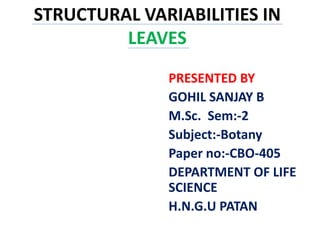
Structural Variations in Hydrophyte Leaves
- 1. STRUCTURAL VARIABILITIES IN LEAVES PRESENTED BY GOHIL SANJAY B M.Sc. Sem:-2 Subject:-Botany Paper no:-CBO-405 DEPARTMENT OF LIFE SCIENCE H.N.G.U PATAN
- 2. CONTENTS • Structural variability in leaves of – 1. Typha 2. Nymphea 3. Maize
- 3. TYPHA • Typha is a hydrophytes. • Plants that grow in water or very wet places. • They may be submerged or partly submerged,floting or amphibious. • Their structural adaptations are mainly due to high water content and the definite supply of oxygen.
- 4. Typha leaf
- 5. Epidermis • In aquatic plants the epidermis is not protective but absorbs gases and nutrients directly from the water. • The epidermis in typical hydrophyte has an extremely thin cuticle,and the thin cellulose wall permit ready absorption from the surrounding water. • Commonly the chloroplast are found in epidermal cells of leaves, especially when the leaves are very thin;these chloroplasts utilize the weak light under water for photosynthesis.
- 6. Lack of sclerenchyma:- • Submerged plants usually have few or no sclerenchymtous tissues and calls. • The water it self gives support to the plant,and protects it to some extent from injury. • Thethick walls of tissues, their density and the presence of collenchyma in some plants give some rigidity.
- 7. Minimum development of vasculae tissue:- • The xylem shows the greatest reduction. • In this plants, there is a well developed xylem lacuma in the position of xylem. • The lacunae resemble typical air-chambers. • The phloem is fairly well developed as compared with the xylem. The endodermis is usually present around stele,but it is wekly developed.
- 8. Development of air-chamber:- • Chambers and passages filled with gases are commonly found in the leaves and stems or hydrophytes. • The air-chambers are large, usually regular, intercellur spaces extending through the leaf and often for long distances through the stem. • The spaces are usually separated by partitions of photosynthetic tissue.the carbon dioxide that is given off in respiration is stored in these cavity for photosynthesis.
- 10. Nymphea • The phyllode is the most interesting modification of petiole. • The petiole becomes flattened and leaf like. • The flattened petiole which looks like ordinary leaf is called phyllode. • Usually the phyllode is isolateral, so that, both the surface are equally illuminated.
- 12. Epidermis:- • It consists of a single row of cells covered with well developed cuticle. • Sunken stomata are present. The margin of phyllode possess radicaly elongated epidermal cells covered with thick cuticle. • Below each stomata there lies a well defined substomatal chamber for exchange of gasese.
- 13. Pallisade and parenchyma:- • Just beneath the epidermis one or two layers of pallisade parenchyma are present which help in photosynthesis. • The central region is occupied by thin-walled living parenchyma cells having well developed intercellular spaces among them.
- 14. Vascular system:- • Just like in petiole the vascular bundles from a ring and are arranged below the palisade tissue. • The central and marginal vascular bundles are sufficiently big in size. • Each vascular bundle consit of xylem and phloem.around the central and marginal vascular bundles well developed sclerenchyma is found.
- 15. • Vascular bundles are arranged in a complete ring the central and marginal bundles are bigger in size. • Pallisade tissue is present • Radically elongated epidermal cells are found at the margins.
- 17. MAIZE
- 18. Epidermis:- • The epidermis is found on both upper and lower surfaces of the leafe. The epidermal layers are uniseriate and composed of more or less oval cells. • The outer wall of the epidermal cells is cuticularized. • The upper epidermis my be easily identified due to the presence of xylem.
- 19. Mesophyll:- • As the leaf is isobilateral the mesophyll is not differentiated into palisade and spongy tissues. • It is composed of compactly arranged thinwalled, isodiametric chlorophyllous intercellular spaces among them.
- 20. Vascular bundles:- • The vascular bundles are collateral and closed as found in monocotyledon. • Most of the bundles are small in size but fairly large bundles also occurs at regulsr intervals. • The xylem is found toward upper side in the bundles.sclerenchyma cell occur in patches on both ends of the large vascular bundles which give mechanical support to the leafe.
- 22. Reference • B P Pandey:-plant Anatomy